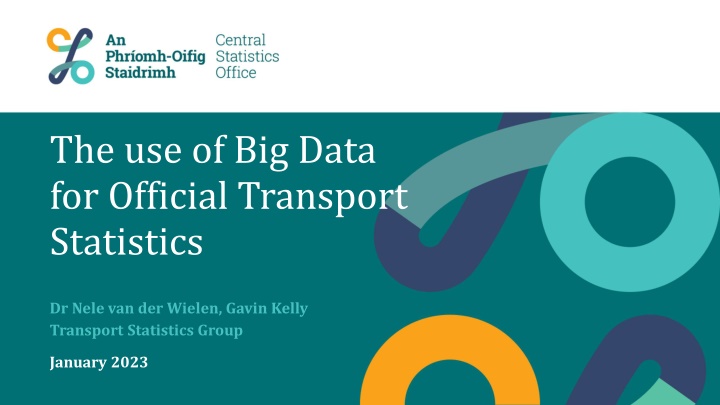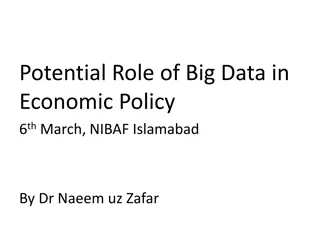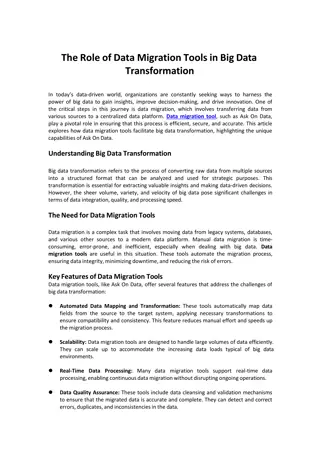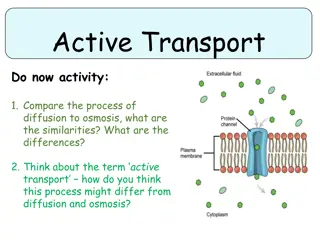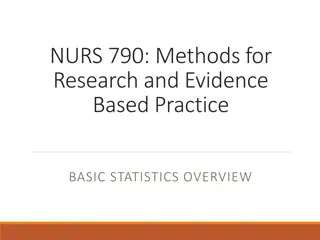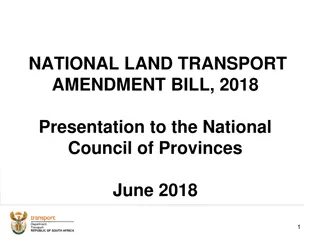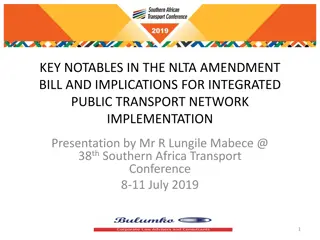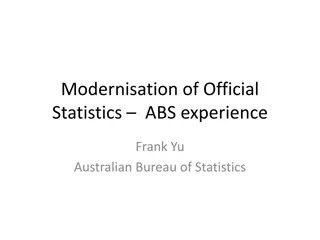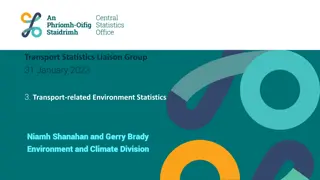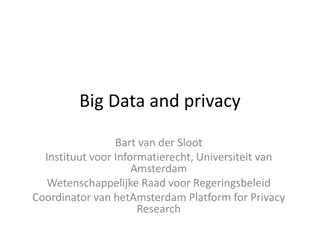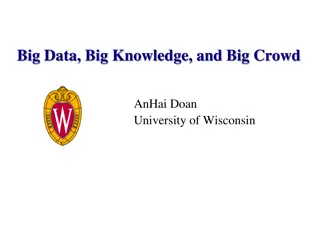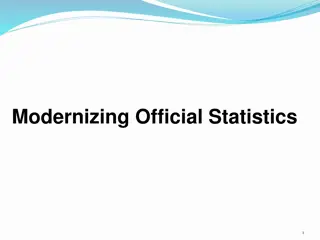Leveraging Big Data for Enhanced Official Transport Statistics
Explore the utilization of big data in official transport statistics, including real-time shipping data for port visits and traffic flow analysis. Discover the motivation, objectives, and benefits of incorporating big data in generating efficient and timely official statistics. Learn about the role of Big Data in reducing respondent burden and enhancing information granularity and accessibility in official statistics.
Uploaded on Oct 11, 2024 | 3 Views
Download Presentation

Please find below an Image/Link to download the presentation.
The content on the website is provided AS IS for your information and personal use only. It may not be sold, licensed, or shared on other websites without obtaining consent from the author.If you encounter any issues during the download, it is possible that the publisher has removed the file from their server.
You are allowed to download the files provided on this website for personal or commercial use, subject to the condition that they are used lawfully. All files are the property of their respective owners.
The content on the website is provided AS IS for your information and personal use only. It may not be sold, licensed, or shared on other websites without obtaining consent from the author.
E N D
Presentation Transcript
The use of Big Data for Official Transport Statistics Dr Nele van der Wielen, Gavin Kelly Transport Statistics Group January 2023
Overview 1. Our Motivation 2. Port Visits Using Real- Time Shipping Data 3. Traffic Flows using TII Traffic Count Data 4. Next Steps 2
Section 1: Our Motivation
Identifying the Problem (1) Fast changing environments 4
Identifying the Problem (2) The value of real-time data became clear in the COVID Crisis in order to assist informed decision- making 5
Mission of the CSO To describe Ireland, its people, economy, society, and environment, through verifiable data and accurate information while providing impartial insight. 6
Our Objectives Faster Indicators: To develop a transport dashboard for flash estimates Big Data: To demonstrate the feasibility of efficient production of official statistics using big data sources Maritime Statistics: To produce timely port call statistics
The Role of Big Data in Official Statistics Reduced respondent burden through automated data collection Opportunity to generate real-time information products Better granularity, coverage, and accessibility 8
Section 2: Port Visits Using Real-Time Shipping Data
Automatic Identification System (AIS) AIS is a receiver and transmitter system used by ships to transmit their position and is used as a safety tool that functions with a combined satellite and ground receiver system: Vessel identifier (MMSI) Date/Time Longitude Latitude Exact Earth API UNGP - AIS Source: UN Department of Economic and Social Affairs Statistics Division
Quality Assurance Big Data sources (including AIS) are not purposely designed for statistical analysis For the CSO, a key question was how the quality of official statistics can be guaranteed: Two methodologies Benchmarking against official statistics Testing and validation exercises 11
Method 1: Boundary Crossing Method (BCM) Method 2: Stationary Marine Broadcast Method (SMBM) 12
Benchmarking Dublin Port was used for validation purposes The period of February 2019 was chosen as the benchmark period MarineTraffic.com data: A sample of arrival and departure data, provided for evaluation by MarineTraffic.com for Dublin port for February 2019 13
Comparison of Official versus AIS-based port calls, Q1 2021 Q1 2022 3500 3000 2500 Number 2000 1500 1000 500 0 2021Q1 2021Q2 2021Q3 2021Q4 2022Q1 Official AIS Port Calls (BCM) AIS Port Calls (SMBM) 14
Port Calls by Ship Type, 2021 100% 90% 80% 70% Unknown General cargo 60% Specialised 50% Container 40% Dry bulk 30% Liquid bulk 20% 10% 0% Official AIS data (BCM) AIS data (SMB) 15
Port Calls by Port, 2021 2500 2000 1500 Number 1000 500 0 Dublin Rosslare Cork Waterford Drogheda Official AIS data (BCM) AIS data (SMB) 16
Conclusion While the AIS methodology produces a slightly higher number of port calls it is clear that the AIS data mirrors the trends in port calls very closely Only small differences exist between the number of vessels that arrived in Irish ports using AIS and administrative data The outcome of this work shows that AIS data have the potential to complement and supplement traditional administrative data sources But not to replace them in the production of official statistics 17
Section 3: Traffic Count Analysis
Data Source Transport Infrastructure Ireland (TII) Traffic Count Data Over 300 working and approved Traffic Monitoring Units (TMU s) Vehicles are detected by passing over loops embedded in the road surface TMU s are located on a range of Road types: Motorways, National Roads and Regional Roads Source: Transport Infrastructure Ireland 19
Quality Assurance Like the AIS Data, TII Traffic Count data is a form of Big Data For the CSO, a key question was how the quality of potentially new official statistics can be guaranteed: Four methodologies Benchmarking against official statistics Testing and validation exercises 20
Methods & Data Preparation Method 1: National Level Statistics Method 3: Tourist Site Analysis Missing Value Imputation Data Cleaning Traffic Count Aggregation Geographical Localisation Method 2: Peak Traffic Flow Times Method 4: Cross Border Travel Statistics 21
National Weekly Car Volumes 2019 & 2022 7000000 6000000 5000000 Traffic Count 4000000 2019 3000000 2022 2000000 1000000 0 1 4 7 10 13 16 19 22 25 28 31 34 37 40 43 46 49 52 Week Number 22
Average Hourly Car Volumes Per TMU 2019 & 2022 (Monday - Friday) 1800 1600 1400 1200 Traffic Volume 1000 2019 800 2022 600 400 200 0 0 1 2 3 4 5 6 7 8 9 10 11 12 13 14 15 16 17 18 19 20 21 22 23 Hour of the Day 23
Average Hourly Car Volumes Per TMU 2019 & 2022 (Weekend) 24
Cross-Border Car Volumes Index: Jan 2019 = 100 140 120 100 80 Index 2019 60 2022 40 20 0 1 2 3 4 5 6 7 8 9 10 11 12 Month 25
Conclusion This is the first time the Central Statistics Office (CSO) has used national level Traffic Count Data to produce statistics on a timelier basis Hourly aggregated daily Traffic Count Data can be used to accurately describe peak traffic patterns Traffic volumes were used generate cross-border travel statistics and tourist activity around selected tourist locations. Overall, the findings of this work confirms that TII data could can be used to produce valid estimates of traffic counts and illustrates the potential of big data for official statistics 27
Section 4: Next Steps
Way Forward Finalise methodology Development of Faster Indicators Transport Dashboard 29
Contact details: transport@cso.ie
